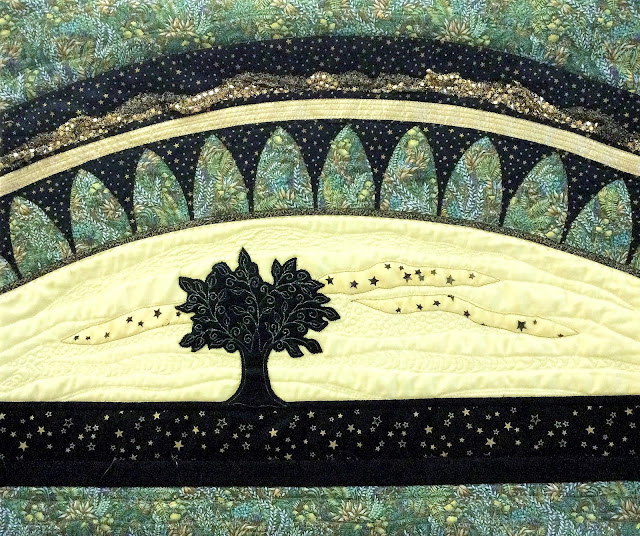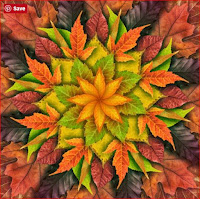February 2021
5x5 inch squares; outline free motion quilting; colour added with Inktense Pencils
Once again, the guild gauntlet has been laid down. This year’s quilting challenge: The Light at
the End of the Tunnel. I’m hoping that
when I read this in a few years’ time I won’t remember why we needed to visit this
particular concept.
It’s now been a year since I’ve seen the other guild members
in person, except for “lucky” circumstances - like when we’ve crossed paths in
the hospital or at the drug store. Such is the wonder of living in a small
city. Like everyone else in my life,
they have receded into figures that populate Zoom meetings, FaceTime sessions,
or primitive non-video phone calls. It’s
a scary fact that the non-family member I’ve seen the most in the last year is
the woman who cuts my hair. And right
now, even she is out of reach, all stores and so-called non-essential services being
closed. Strangely, dog groomers are
open. They refuse to cut my hair.
These are trying times.
Yes, it’s COVID time. We’re one year into a pandemic. Each dwelling
is a private fortress. No non-family member can enter your personal Fortress of Solitude. You can leave, but only at your own peril.
Social gatherings, travel, and shopping have fallen into the forbidden zone;
fashion has ceased to exist unless you are considering what face mask matches your
parka. We have all become major
consumers of alcohol – on our hands. For
the first time in my privileged life, I am witnessing poorly stocked shelves in
grocery stores, something I’d previously thought impossible.
“What doesn’t kill you makes you stronger”. This bit of folk wisdom basically means, meh,
wait it out. You’ll adapt. You won’t
necessarily be made stronger by adversity, but as time passes the hideous
situation you’re facing will seem less onerous, giving you the illusion that
you are stronger. And really, you don’t
need much more than illusion to get through situations you can’t possibly
change.
Different people are coping with the pandemic in different
ways. My sister is accessing every
written word and podcast on the subject of coronavirus, knowledge being a cushioning
sword. My husband is tracking vaccine
news at a fevered pace that has me running for the thermometer. He gives hourly reports on the
hopeful/shocking/enraging/encouraging statistics as they vacillate like
lathered-up horses toiling along in the Kentucky Derby.
So, you can see why Light at the End of the Tunnel became the
concept for this year’s quilting challenge.
Now there doesn’t have to be an actual tunnel, the idea is to create
something that makes you feel joyful, happy or hopeful. Actually, reading over
the minutes of the last meeting, I see it is “joyful, happy and
hopeful”, but I’m pretty sure in that tall order, “or” should be substituted
for “and”. Nailing all three seems more
like a lifetime pursuit, not a quilting challenge.
Of course, I am inclined to take things in a literal
direction, so I immediately started exploring tunnels. Virtually, of course. I looked at online photos of tunnels, and
investigated arches as well, because when seen in a disappearing cascade, they suggest
tunnelishness. Concentric rings and the
like were also potential creative fodder. All of these photos looked great, but, ugh,
what about that ever-present monster, The
Copyright Beast? Of sure, you can try to
contact the photographer to get permission to do a derivative work, but, HA,
just try to find that mythical unicorn-of-a-person after their photo has been
sent through the mill of Google and Pinterest postings! Sherlock Holmes would despair of ever pulling the
cat of that labyrinthic bag.
Never mind the photos. I drew a picture of a tunnel (okay,
it was just a doodle) but could not make myself scale it up into a quilt. It
seemed like something that would reactivate my vertigo if it ballooned into
anything big enough to be hung on the wall.
I didn’t want to quilt anything that would require maintaining an
ongoing therapeutic level of Gravol in my bloodstream.
I consulted some photos we had taken of Kettle Valley Steam Railway in British
Columbia. This is a tourist site of walking
trails through defunct railway tunnels.
My photos were so-so. I had been
more enamored with the rarity of playing with a flashlight in a tunnel than I
was of capturing clever, nested tunnel photos.
Nothing quilt-worthy there. Maybe I could do a flashlight in a tunnel...oh wait, I forgot to take a picture of that.
I consulted my artist friend. She’s not a quilter, but when it comes to
designing something, your medium of choice doesn’t matter. Through discussions with her, I was yanked out
of my blocked tunnel and into thinking about the actual concepts at
stake: joy, happiness, hope. I started
to think that COVID with its seemingly infinite imposed limitations was perhaps
not the first “tunnel” I had encountered.
Every life comes with at least a dollop of adversity, and
sometimes it comes with gobs, shovelfuls, or even truckloads of the
stuff. It’s part of living, and like the
days where you realize you left your wallet at home after pumping the gas, there’s
just no getting around it. But
sometimes, you can temporarily escape from hardship. Like everything else to do with the pandemic,
it will have to be a virtual escape. And
while I’ve been known to perform my virtual escape act with tubs of ice cream,
I do have to admit that is a fairly risky option if deployed too often. And I have a drawer full of elastic topped pants
to prove it.
But…what about…fiction? Haven’t I done a disappearing act into
fiction since I first encountered Beaky the Greedy Duck (so, so, SO, much more greedy
and imperfect than me!) and Nancy Drew?
Didn’t I solve mysteries with Nancy when I lacked a playmate (as close
as I got to the “end of the world” in my gloriously simple childhood) or the day
I broke the frog flowerpot? Didn’t I fight
jungle ants with Tom Stetson when boredom threatened to chew off the edges of
my soul? Weren’t Charlie Brown and
Snoopy my guiding lights who were not only funny but who seemed perhaps a
little less lucky than me, making my own particular tunnel a little shinier? These beacons were the collective fictional
souls who had populated my childhood when the real stuff was, well, just too real.
Surely, they were quilt worthy. I
wondered if using images of them would awaken the slumbering Copyright Police. It’s a good thing Charles
Schultz wasn’t looking over my shoulder during all those hours when eight-year-old
me was trying to perfect my own Snoopy drawings!
I decided I would have to be willing to just take the insane risk of
having Charles Shultz’s estate sue me for stitching one image of Charlie
Brown. Surely, they would not do this to
me after I’d spent the better part of my allowance on those 40 cent joke books
for years on end, and then sheltered those same books for over fifty years. They would show compassion. It’s pandemic
time! We all have to make sacrifices.

So, I’ve taken Charlie Brown and Snoopy and characters from
Frogmorton, and I’ve outline stitched them onto unbleached cotton, and coloured
them with Inktense pencils. I
have no idea if these squares and the others honoring my favorite fictional
characters will ever make it into a finished quilt, or if perhaps they will
just end up in a really pretty box sharing space with the dust bunnies under
the bed. But, while making these squares, I have indeed experienced joy, happiness, and
hopefulness. I’ve also experienced the
nostalgia of knowing that every member of my childhood household read these Peanuts
joke books. Numerous times. And there it is - the light at not only the end of the tunnel,
but at the beginning as well.
















